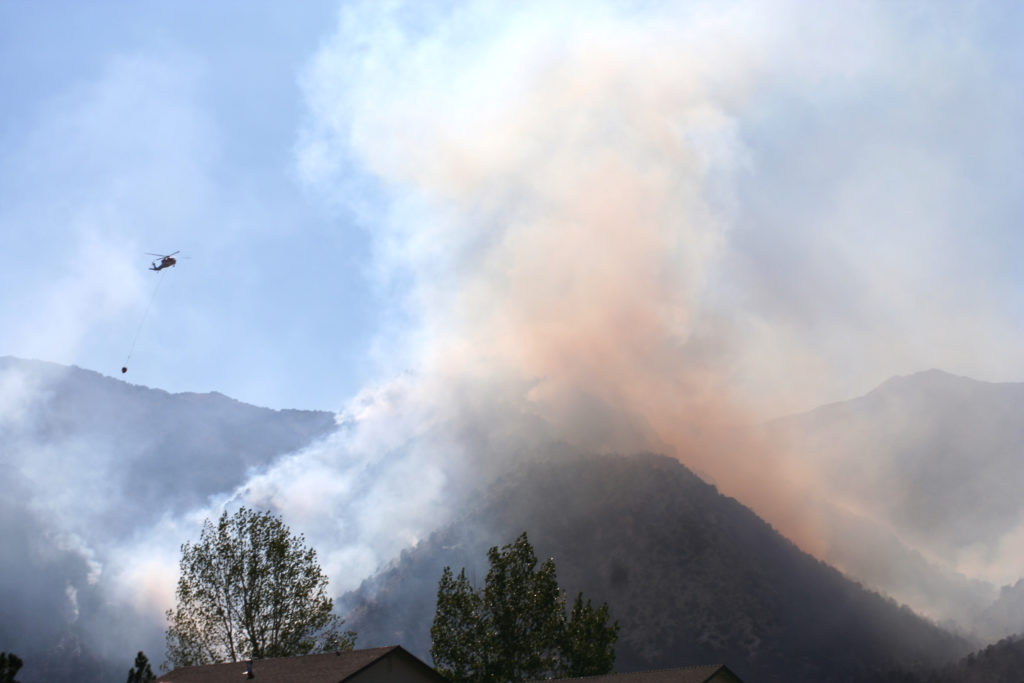Six ways to Prepare Now for Wildfire
June 29th, 2018
“Once I saw the plume of smoke I quickly determined a list of to-go bag items and removed the dead plants from my deck.” This was the beginning of a conversation that I had with an individual regarding a recent wildfire and what his thought process was once he saw smoke from his residence. This individual and I joked that these preparations could have been made a little earlier. Fortunately this wildfire was fully contained shortly thereafter with no structures or lives lost. However, many people are guilty of racing to prepare for wildfire once it begins, including myself. Read “A Close Call During the Driscoll Fire”. Many don’t realize that the actions taken before a wildfire play a huge role in reducing the risk of wildfire on homes. Below is a list of six ways that residents can prepare now for wildfire:
1) Be Ember Aware
It’s estimated that 90% of the homes destroyed during a wildfire are due to wind-blown embers. Many don’t realize that wind-blown embers can travel up to a mile ahead of a wildfire. When they land on, in or around something easily ignitable, the home can be vulnerable to ignition and complete destruction. Taking the proper precautions to ensure that a home is ember prepared can reduce the threat of wildfire ignition to a home. Some items to consider are: Replace your wood shake roof with a metal, composite or tile roof and keep rain gutters free of dead plant material such as dried leaves or pine needles.
See where homes can be vulnerable to an ember attack
2) Begin and Maintain your Defensible Space
Defensible space is the area between your home and an oncoming wildfire where the vegetation has been managed to reduce the risk of wildfire and where firefighters can safely defend your home. For example, the first five feet from a home is an important area to keep noncombustible in order to reduce the risk of ignition from embers. Homeowners can use herbaceous plants like lawn, ground cover and flowers; rocks, concrete, brick and pavers; and should keep it free of woodpiles, dead plant material and flammable shrubs and debris.
3) Review your Family Emergency Plan and Practice a Family Evacuation
It’s important to know how to safely and effectively evacuate during an emergency especially if residents need to evacuate quickly. One important element is that everyone in the family should know the best escape route out of the home and know two routes out of each room.
Learn more on how to prepare for Evacuation
4) Register with your Local Emergency Response System (also known as Reverse 911)
This may be the most important step you can take. Local Emergency Response Systems, commonly known as Reverse 911, is used by safety officials to send phone calls, emails and texts to a specific area with a prepared message during an emergency. For example, if an area is asked to evacuate, this message will be sent to all of those residents who are in the system. Some residents might not receive these messages if the electricity fails, if the resident isn’t home during an emergency, does not have a land line, or if they have an unlisted phone number. Most systems allow residents to enter multiple forms of contact information, such as unlisted home number, cell phone, work phone and email address into the database. The following are links on how to register for counties and areas that offer this service:
- Carson City
- Douglas County
- Lander County
- Lincoln County
- Lyon County
- Washoe County
- White Pine County
- Las Vegas, Henderson, North Las Vegas, Mesquite & Boulder City and Clark County
5) Complete a Home Inventory
If a fire destroyed your home, could you remember the estimated value and date of purchase for all your possessions for insurance purposes? Yeah, me neither! A home inventory is important as it provides an accurate record of a homeowner’s possessions, helps process insurance claims faster and helps one purchase the correct amount of insurance. The inventory is an important tool to document losses from a fire but also from other causes such as flooding, burglary and vandalism. Residents can inventory their belonging using a smart phone app, or an inventory sheet. Consider creating videos of your possessions as well.
Read a review of three ways to complete a home inventory
6) Pack a To-Go Bag
A to-go bag should be packed in advance with specific items so residents can quickly and safely evacuate their home. Sometimes, this may be all that individuals have time to grab. Things to consider packing can include: a battery powered or hand crank radio, extra batteries, first aid kit, medications, clothing, personal toiletries, flashlight, cell phone with charger, extra set of car and house keys, contact information for family, friends and physicians, copies of personal documents such as your home inventory, bank, IRS, trust, investment, insurance policies, birth certificates, marriage certificates, death certificates, medical and immunization records, wills, contracts, titles and deeds. For more on what to pack
This is a ton of information to take in and to do, but it’s important to prepare now for wildfire. To learn more about how to prepare for wildfire

Jamie Roice-Gomes is the outreach coordinator with University of Nevada Cooperative Extension’s Living with Fire Program. She earned her Bachelor of Science in Wildlife Ecology and Conservation and a Master of Arts in Interactive Environmental Journalism. She was a public relations assistant for Conrad Communications, a public information officer intern at the Nevada Department of Conservation & Natural Resources, and a Biological Science Technician at the USDA-Agriculture Research Service. She also enjoys volleyball, the Great Basin Desert, and spending time with family. Contact Jamie at 775-336-0261 or roicej@unce.unr.edu.
